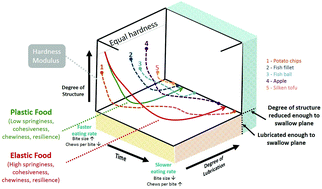当前位置:
X-MOL 学术
›
Food Funct.
›
论文详情
Our official English website, www.x-mol.net, welcomes your
feedback! (Note: you will need to create a separate account there.)
Correlation of instrumental texture properties from textural profile analysis (TPA) with eating behaviours and macronutrient composition for a wide range of solid foods†
Food & Function ( IF 5.1 ) Pub Date : 2018-09-18 00:00:00 , DOI: 10.1039/c8fo00791h May Sui Mei Wee 1, 2, 3, 4, 5 , Ai Ting Goh 1, 2, 3, 4, 5 , Markus Stieger 6, 7, 8, 9 , Ciarán G. Forde 1, 2, 3, 4, 5
Food & Function ( IF 5.1 ) Pub Date : 2018-09-18 00:00:00 , DOI: 10.1039/c8fo00791h May Sui Mei Wee 1, 2, 3, 4, 5 , Ai Ting Goh 1, 2, 3, 4, 5 , Markus Stieger 6, 7, 8, 9 , Ciarán G. Forde 1, 2, 3, 4, 5
Affiliation

|
Faster eating rates have previously been associated with higher ad libitum energy intakes, and several studies have manipulated eating rates and intake by changing food textures. Food texture based changes to slow eating rates can produce reductions in energy intake without affecting post-meal satisfaction or re-bound hunger. However, an understanding of how specific food textures and instrumental texture properties influence oral processing behaviour remains limited. The current study sought to establish relationships between objective measures of oral processing behaviour (i.e. number of bites, average bite size, total chews, chews per bite, oro-sensory exposure time and eating rate) and instrumental measures of a food texture including hardness, adhesiveness, springiness, cohesiveness, chewiness, resilience and modulus. Across two studies, behavioural coding analysis was completed on video-recordings of participants consuming fixed portions of a wide range of different solid foods (n = 59) to derive objective measures of oral processing behaviours. These measures were correlated with instrumental Textural Profile Analysis (TPA) for the same set of foods. Significant correlations (p < 0.05) were found between oral processing parameters and texture properties (i.e. springiness, cohesiveness, chewiness and resilience). No significant correlations were found between hardness and modulus and oral processing parameters. Protein content of the food was associated with springiness and chewiness, which may help to further reduce eating rates. In terms of the ‘breakdown path model’, hardness and modulus might represent degree of initial food structure while springiness, cohesiveness, chewiness and resilience seem to determine how fast the degree of structure is reduced to the swallowing plane. Water content and adhesiveness were associated with level of lubrication that is required before reaching the swallowing plane. The current study highlights opportunities to understand eating rate (g min−1) through the breakdown path model and the potential for specific features of a foods texture to influence rate and extent of energy intake. The correlation between instrumental texture properties and oral processing patterns provides guidance on the parameters that are likely to produce ‘faster’ and ‘slower’ versions of foods, and suggests how texture modifications could be applied to moderate eating rate and energy intake within meals.
中文翻译:

多种固体食品的质地特征分析(TPA)的仪器质地特性与进食行为和大量营养成分的相关性†
以前,较高的进食速度与较高的随意摄入能量有关,一些研究通过改变食物的质地来控制进食速度和摄入量。基于食物质地的低速进餐变化可以减少能量摄入,而不会影响餐后满意度或饥饿感。然而,对特定食物质地和仪器质地特性如何影响口腔加工行为的理解仍然有限。目前的研究旨在建立口腔处理行为客观指标之间的关系(即咬伤,平均一口大小,总咀嚼,咀嚼每一口的数量,奥罗感官的曝光时间和可食率)和食品质地的工具措施,包括硬度,附着力,弹性,内聚力,耐嚼性,弹性和模量。在两项研究中,行为编码分析是根据参加者食用大量不同固体食物(n = 59)的固定部分的视频记录而完成的,以得出口头加工行为的客观衡量指标。这些措施与同一组食物的仪器质地轮廓分析(TPA)相关联。口腔加工参数和质地特性(如弹性,内聚力,耐嚼性和弹性)之间存在显着相关性(p <0.05))。在硬度和模量与口腔加工参数之间未发现显着相关性。食物中的蛋白质含量与弹性和咀嚼性有关,这可能有助于进一步降低进食率。就“分解路径模型”而言,硬度和模量可能代表初始食物结构的程度,而弹性,内聚力,耐嚼性和回弹力似乎决定了结构度降低到吞咽平面的速度。水分和附着力与到达吞咽平面之前所需的润滑水平有关。当前的研究强调了通过分解路径模型了解进食率(g min -1)的机会,以及食物质地特定特征可能影响进食率和能量吸收程度的可能性。仪器质地特性与口腔加工模式之间的相关性为可能产生“更快”和“更低”版本食物的参数提供了指导,并建议如何将质地修改应用于适度的进食速度和进餐中的能量摄入。
更新日期:2018-09-18
中文翻译:

多种固体食品的质地特征分析(TPA)的仪器质地特性与进食行为和大量营养成分的相关性†
以前,较高的进食速度与较高的随意摄入能量有关,一些研究通过改变食物的质地来控制进食速度和摄入量。基于食物质地的低速进餐变化可以减少能量摄入,而不会影响餐后满意度或饥饿感。然而,对特定食物质地和仪器质地特性如何影响口腔加工行为的理解仍然有限。目前的研究旨在建立口腔处理行为客观指标之间的关系(即咬伤,平均一口大小,总咀嚼,咀嚼每一口的数量,奥罗感官的曝光时间和可食率)和食品质地的工具措施,包括硬度,附着力,弹性,内聚力,耐嚼性,弹性和模量。在两项研究中,行为编码分析是根据参加者食用大量不同固体食物(n = 59)的固定部分的视频记录而完成的,以得出口头加工行为的客观衡量指标。这些措施与同一组食物的仪器质地轮廓分析(TPA)相关联。口腔加工参数和质地特性(如弹性,内聚力,耐嚼性和弹性)之间存在显着相关性(p <0.05))。在硬度和模量与口腔加工参数之间未发现显着相关性。食物中的蛋白质含量与弹性和咀嚼性有关,这可能有助于进一步降低进食率。就“分解路径模型”而言,硬度和模量可能代表初始食物结构的程度,而弹性,内聚力,耐嚼性和回弹力似乎决定了结构度降低到吞咽平面的速度。水分和附着力与到达吞咽平面之前所需的润滑水平有关。当前的研究强调了通过分解路径模型了解进食率(g min -1)的机会,以及食物质地特定特征可能影响进食率和能量吸收程度的可能性。仪器质地特性与口腔加工模式之间的相关性为可能产生“更快”和“更低”版本食物的参数提供了指导,并建议如何将质地修改应用于适度的进食速度和进餐中的能量摄入。











































 京公网安备 11010802027423号
京公网安备 11010802027423号